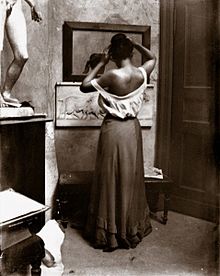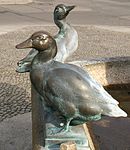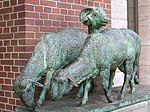August Gaul
Georg August Gaul (born October 22, 1869 in Großauheim , † October 18, 1921 in Berlin ) was a German sculptor and medalist in the transition from historicism to modernism .
Life
August Gaul was a son of the stonemason Philipp Gaul (1840-1910) and his wife Katharina (1838-1882). He received his first ideas for his future career in his father's workshop. He completed an apprenticeship as a modeller and chaser in a silver goods factory, and since 1884 he was a student at the royal Prussian drawing academy in Hanau . With the support of his professor there, the sculptor Max Wiese , he went to Berlin in 1888. There he first worked in the sculpture studio of Alexander Calandrelli and took courses at the teaching institution of the Berlin Museum of Decorative Arts .
After he had won a permanent free ticket for the Berlin Zoological Garden in 1890 , he carried out intensive drawing studies there, often early in the day. In 1894 he began studying at the Berlin Art Academy , he attended the class of the painter Paul Meyerheim , whose particular strength was the depiction of animals.
In 1895 Gaul began his activity as a master student in the studio of Reinhold Begas , the leading exponent of Neo-Baroque in the Berlin School of Sculpture . Begas left him and August Kraus to work on two of the four lions each for his Kaiser Wilhelm national monument in front of the Berlin City Palace . The SED had the memorial removed in 1950, only the lions were spared and came in 1963 in front of the predator house in the Berlin- Friedrichsfelde zoo. A prize that the academy had awarded him for a relief enabled Gaul to study in Italy in 1897/1898.
After his return he became better known for his sculpture of the two Roman goats , which he was also able to show at the Paris World Exhibition in 1900 . In 1898 he was one of the founding members of the Berlin Secession , an association of artists such as Max Liebermann , Louis Tuaillon and Walter Leistikow , who turned against the prevailing academic art business; from 1902 he was on the board of the Secession. In 1900 Gaul married Clara Haertel (1874–1940) in Berlin-Wilmersdorf , and they had two daughters and a son.
The Secession's executive secretaries were cousins Bruno and Paul Cassirer , who ran an art gallery in Berlin. The gallery owners found Gaul well-funded customers such as the entrepreneur Eduard Arnhold , the newspaper publisher Rudolf Mosse and the shipowner Albert Ballin . Museum directors such as Alfred Lichtwark , who acquired nine animal sculptures for the Hamburger Kunsthalle in 1906, were also among the early interested parties . Such contacts offered a satisfactory compensation, at least financially, for some unsuccessful attempts to get orders for larger works in public space in Berlin. In 1905 Gaul had won a competition for a monument on Steinplatz in Charlottenburg with the design of a fountain . The sculpture did not show the Freiherr von Stein, but an elephant and a group of pelicans. The elephant fountain project sparked discussions in which Christian Morgenstern defended Gaul with a poem. However, the well was not built.
The sculptor's close friends included his professional colleagues Bernhard Heising and Ernst Barlach as well as the painters Heinrich Zille and Benno Berneis . The latter also stood as a model for August Gaul's statue of Mercury on the Hamburg Klöpperhaus , which is one of the artist's few sculptures that depict human beings. The rather introverted August Gaul became especially friends with the cheerful Paul Cassirer (in the circle of friends they were also called "Paulchen and Gaulchen"), the gallery owner was also at his side during the hour of Gaul's death and later tried to settle the artistic estate.
August Gaul was appointed professor at the art academy in 1908 and appointed to the purchasing committee of the Berlin National Gallery in 1919. He died in 1921 shortly after being appointed senator at the Akademie der Künste without being able to take up this post. His honorary grave of the city of Berlin is in field 7 at the Berlin cemetery Dahlem .
Swan chick fountain (1908), Berlin-Charlottenburg , Kurfürstendamm 61
Entenbrunnen (1911), Berlin-Charlottenburg, in front of the Renaissance theater
Goldener Hirsch (1912), Berlin-Schöneberg , in Rudolph-Wilde-Park
To the work
From his training and through his work with Reinhold Begas, Gaul was connected to historicism, especially the neo-baroque, a representative, sometimes pathetic style with demanding motifs and often complicated forms. His study visit to Italy in 1897/1898 brought about a fundamental reorientation. Through the sculptor Louis Tuaillon (1862–1919), who stayed in Rome between 1885 and 1903 and was in turn influenced by Adolf von Hildebrand (1847–1921), Gaul got to know his teachings and working methods. Hildebrand lived alternately in Italy and Munich from around 1870. His sculptures were characterized by calm forms and by the renunciation of all details that were dispensable for an understanding of the whole; thus he formed an artistic antithesis to Begas. In 1893, he described his ideas in the publication On the Problem of Form in Fine Arts .

As a result, August Gaul oriented himself to these guidelines and applied them to his own work. He emphasized the three-dimensional qualities, showed the animals in a calm, typical attitude, focused on the essentials, largely free of materially based structures. With this factual view, he anticipated the characteristics of the incipient modern age. Contemporary observers mentioned several times a reference to ancient Egyptian and ancient sculpture that Gaul had dealt with; The art historian Emil Waldmann wrote in 1919: Only when he looked at Egyptian and Etruscan and archaic-Greek things did he know how to face nature… . Such comparisons had to remain superficial, they could only concern the shape. The religious and symbolic background of the early sculptures was of no importance to Gaul. He himself described his work as follows: I do not want to pedantically imitate nature, but rather capture the typical and its soul. Above all, I want to do sculptural work (...) What attracts me to animals is essentially artistic. I make animals because I am happy.
Animal sculpture is clearly at the center of his life's work. Only three representations of people are known, including a donkey rider in the foyer of the Berlin-Spandau town hall , for which the sculptor's son was the model. In Berlin there are two smaller fountains with ducks and swan chicks, but Gaul was primarily interested in non-domesticated animals such as lions, bears and monkeys, rams and bison , sea lions, penguins and otters. Two bison sculptures adorn the staircase of the Kiel art gallery . He received a lot of applause for a large standing lioness at the 1901 Secession exhibition; the work stood in the garden of Eduard Arnhold's Berlin villa until after the end of the Second World War ; it can now be found in the Großauheim Museum. The large sculpture Fighting Wisente , erected in Königsberg (now Kaliningrad ) in 1912 , is one of the city's most famous monuments. A large-format eagle , originally commissioned by Albert Ballin for the gateway to his villa in Hamburg, has been an aviator memorial that can be seen from afar on the Wasserkuppe in the Rhön since 1923 . Two further copies are kept in the Kunsthalle Hamburg and in the Alte Nationalgalerie in Berlin. Some of Gaul's animal sculptures can be seen in his birthplace Hanau-Großauheim, in front of the house at the fountain (6 penguins by August Gaul on a fountain basin newly created by the Frankfurt sculptor Eberhard Franz Gutberlet in 2013), in the Hauptstraße 62 area (at the beginning of the Hanauer Landstrasse) and in the Großauheim Museum . One of the largest preserved Gaul collections was also brought together by the Jewish couple Hugo and Elise Zwillenberg , especially in Berlin in the 1920s. When they emigrated in the spring of 1939, they took the collection out of the country; it survived the war in the free port of Amsterdam unscathed. In the early 1960s, the Zwillenbergs moved together with the collection consisting of around 120 mostly small-figure pieces from Amsterdam to Bern; In 2003 the restitution of the large sculpture of a young elephant (made in 1916) from the Czech Republic took place. This collection has been on permanent loan from the Zwillenberg Foundation in the Kunstmuseum Bern since summer 2013 .
Gaul's metal sculptures were made in the renowned Hermann Noack fine art foundry in Berlin and, as far as the smaller formats were concerned, were offered by Cassirer in limited numbers. After the artist's death, Paul Cassirer , Barlach and Gaul's student Max Esser made a list of the exemplary works that were still to be cast in limited editions. Gaul's son-in-law, his daughter Charlotte's husband, ignored the experts' recommendation and very soon had a large number of other motifs cast and offered for sale. The interest in Gaul's sculptures is still great today, but the situation on the art market is confusing. An art history publication from 2007 tries to reliably distinguish secured originals - around 300 in the latest catalog raisonné - from unauthorized reproductions.
Donkey rider, Berlin, Spandau Town Hall
Sheep, Hamburg, Klöpperhaus in Mönckebergstrasse
Eagle sculpture on the aviator memorial on the Wasserkuppe
Fighting bison in Koenigsberg
European bison on the steps of the Kunsthalle Kiel
August Gaul plaque
On the occasion of August Gaul's 100th birthday, the city of Großauheim created a bronze plaque in 1969 with a picture, name and dates of the artist's life. It is awarded to personalities who have made particular cultural or artistic contributions. After the regional reform in Hesse , the city of Hanau took over the awarding of this award in 1980 .
Recent exhibitions
- 2009: The animal sculptor August Gaul. Georg Kolbe Museum , Berlin
- 2010/2011: August Gaul - Fritz Klimsch . Museum Giersch , Frankfurt am Main
- 2011: The Fate of Sculpture: August Gaul (1869–1921). Small zoo. Georg Schäfer Museum , Schweinfurt
- 2011: August Gaul - The Alfons and Marianne Kottmann Collection. Historical Museum Hanau , Philippsruhe Castle , Hanau
- 2011–2012: Liebermann Villa , Berlin-Wannsee
- 2014–2015: August Gaul and Martin Lauterburg. Art Museum Bern
- 2019–2020: August Gaul - Because I'm happy . Grossauheim Museum
literature
- Hans Rosenhagen : sculptures by August Gaul. Paul Cassirer, Berlin 1905.
- Emil Waldmann : August Gaul. Paul Cassirer, Berlin 1919.
- Paul Cassirer : Old animal fables with stone drawings by Aug. Gaul. Panpresse, Leipzig 1919.
- posthumously
- Angelo Walther : Gaul, Georg August. In: New German Biography (NDB). Volume 6, Duncker & Humblot, Berlin 1964, ISBN 3-428-00187-7 , p. 98 ( digitized version ).
- Angelo Walther: August Gaul. Artist Compendium. EA Seemann , Leipzig 1973. (with 262 illustrations, 136 of which are sculptures)
- Ursel Berger: The animal sculptor August Gaul. (Exhibition catalog) Nicolai, Berlin 1999, ISBN 3-87584-858-6 .
- Arie Hartog (conception), Gerhard Marcks Foundation (ed.): The zoo, the wilderness and the pasture. German animal sculptures from August Gaul to Joseph Beuys. (Exhibition catalog) Gerhard Marcks Foundation, Bremen 2002, ISBN 3-924412-42-1 .
- Hilde Eich: August Gaul: October 22, 1869 - October 18, 1921. Museum Großauheim, Hanau-Großauheim 2003, ISBN 3-00-012032-7 .
- Josephine Gabler: Catalog raisonné of the sculptures by August Gaul. Jaron-Verlag, Berlin 2007, ISBN 978-3-89773-569-9 .
- Angelo Walther: Gaul, August . In: General Artist Lexicon . The visual artists of all times and peoples (AKL). Volume 50, Saur, Munich a. a. 2006, ISBN 3-598-22790-6 , pp. 227-229.
Web links
- Literature by and about August Gaul in the catalog of the German National Library
- Biography August Gaul at Edition Luisenstadt
- Image gallery August Gaul on the website of the city of Hanau (with photos of sculptures)
- Panorama Museum Großauheim - August Gaul collection
- Journal Berliner Leben , Issue 7 (1902), short biography and illustration of some works by August Gaul
Individual evidence
- ↑ artist. August Gaul. German Society for Medal Art, accessed on July 12, 2014 .
- ↑ Hans-Werner Klünner (ed.): Berlin places. Photographs by Max Missmann . Nicolai, Berlin 1996, ISBN 3-87584-610-9 , p. 24/25.
- ↑ Where to find August Gaul. In: Mainpost.
- ^ Website of the city of Hanau
- ↑ Wisent August Gaul ( page no longer available , search in web archives ) Info: The link was automatically marked as defective. Please check the link according to the instructions and then remove this notice. at Europeana .
- ↑ The Wasserkuppe Aviation Monument. Retrieved September 22, 2018 .
- ↑ http://swissart.ch/de/swissart_news.php?article_id=256 .
- ↑ Archive link ( Memento of the original from February 23, 2015 in the Internet Archive ) Info: The archive link was inserted automatically and has not yet been checked. Please check the original and archive link according to the instructions and then remove this notice. .
- ↑ Even the young elephant owned by the Zwillenberg Foundation was restored by Noack in 2003 - now by the third and fourth generation.
- ^ Josephine Gabler: August Gaul. The catalog raisonné of the sculptures. Jaron-Verlag, Berlin 2007, ISBN 978-3-89773-569-9 .
- ^ Website of the city of Hanau
- ↑ [1]
| personal data | |
|---|---|
| SURNAME | Gaul, August |
| ALTERNATIVE NAMES | Gaul, Georg August (full name) |
| BRIEF DESCRIPTION | German sculptor |
| DATE OF BIRTH | October 22, 1869 |
| PLACE OF BIRTH | Grossauheim |
| DATE OF DEATH | October 18, 1921 |
| Place of death | Berlin |












